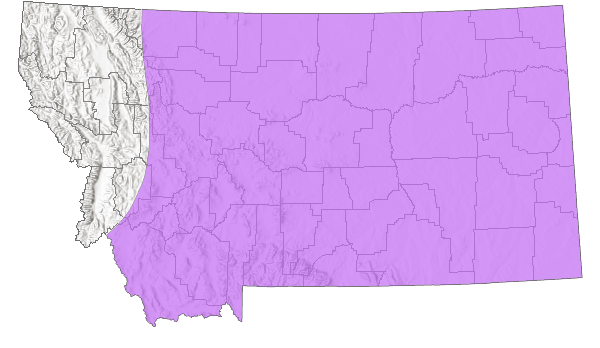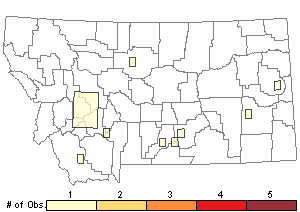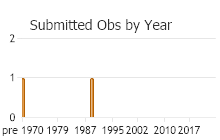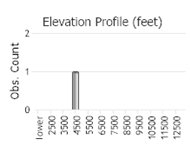View in other NatureServe Network Field Guides
NatureServe
Montana
Utah
Wyoming
Idaho
Wisconsin
British Columbia
South Carolina
Yukon
California
New York
Thistle Grasshopper - Aeoloplides turnbulli
Other Names:
Russian Thistle Grasshopper, Turnbull's Grasshopper
General Description
The following is taken from Vickery and Kevan (1985), Phadt (2002), Capinera et al. (2004), and Scott (2010). This is a medium-sized grasshopper. The body length to end of forewings is 16-20 mm for males, and females 19-25 mm. Usually greenish but can vary from tan or grayish. A dark stripe occurs on the dorsal surface of the head and extends onto the pronotum. A dark stripe crosses the lateral lobe of the pronotum. The forewings are pale green or brown and can be shorter or longer than the abdomen. The hind femur has 3 dark stripes, and the tibia is bluish or bluish-green. The tip of the abdomen bears a small protuberance.
Phenology
The Thistle Grasshopper passes the winter in the egg stage and is an early hatching species. The first instar nymphs begin appearing late April or the first of May. Adults occur into October, depending upon temperatures and other weather factors (Vickery and Kevan 1985, Phadt 2002, Capinera et al. 2004).
Diagnostic Characteristics
The following is taken from Vickery and Kevan (1985), Phadt (2002), Capinera et al. (2004), and Scott (2010). Most useful characteristics are: 1) Shape of the pronotal disk, which widens progressively from front to rear. 2) A triangular pointed cercus of the male’s genitalia. 3) Pointed ventral spine between front legs. 4) Three dark markings on the upper medial area of the femur. 5) Hind tibia medium blue with a pale tan ring at the base.
The Thistle Grasshopper can be confused with species in the genus Melanoplus. It is distinguished by the shape of the spine protruding ventrally between the front legs. The spine is more slender and sharply pointed in this species than in the Melanoplus (Capinera et al. 2004).
Species Range
Montana Range
Range Descriptions

 Native
Native
Range Comments
Year-round, non-migratory resident. Occurs over the eastern two thirds of Montana, extending into southeast Idaho. It is a western Great Plains species ranging from Alberta and Saskatchewan, south to the Mexican border in west Texas and extends eastward through the Dakotas, Nebraska, Kansas, and Oklahoma (Capinera et. al. 2004, Pfadt 2002, Scott 2010, Vickery et. al. 1985).
Observations in Montana Natural Heritage Program Database
Number of Observations: 12
(Click on the following maps and charts to see full sized version)
Map Help and Descriptions
Relative Density

Recency



 (Observations spanning multiple months or years are excluded from time charts)
(Observations spanning multiple months or years are excluded from time charts)
Habitat
Thistle Grasshoppers inhabit desert shrub, alkali flats with saltbush and
black greasewood (
Sarcobatus vermiculatus), and grasslands. Their habitats are usually on disturbed land, crop borders, and weedy rangelands (Capinera et al. 1982 and 2004, Pfadt 2002).
Food Habits
This species feeds primarily on forbs and some woody shrubs of the
Chenopodiaceae such as:
Russian thistle (
Salsola tragus),
common kochia (
Kochia scoparia),
white goosefoot (
Chenopodium album), and
saltbush sp. It does not feed on grasses. There have been reports of this species reaching high population densities (outbreaks) and damaging sugarbeet crops. Overall, this species in considered beneficial in suppressing weedy species (Capinera et al. 1982 and 2004, Pfadt 2002).
Reproductive Characteristics
The following is taken from Capinera et al. (1982, 2004) and Pfadt (2002). Observations indicate that eggs are laid on bare ground in pods, consisting of 12 to 18 eggs. This species’ fecundity is high. One lab study of six caged females produced an average of 250 eggs each. Upon hatching, the nymphs grow through 5 nymphal instars and have a relatively long development period to the adult stage ranging from 50 to 60 days.
Stewardship Responsibility
References
- Literature Cited AboveLegend:
 View Online Publication
View Online Publication Capinera, J.L. and T.S. Sechrist. 1982. Grasshoppers of Colorado: Identification, Biology, and Management. Fort Collins, CO: Colorado State University Experiment Station, Bulletin 584S. 161 p.
Capinera, J.L. and T.S. Sechrist. 1982. Grasshoppers of Colorado: Identification, Biology, and Management. Fort Collins, CO: Colorado State University Experiment Station, Bulletin 584S. 161 p. Capinera, J.L., R.D. Scott, and T.J. Walker. 2004. Field Guide to Grasshoppers, Katydids, and Crickets of the United States. Ithaca, NY. Cornell University Press.
Capinera, J.L., R.D. Scott, and T.J. Walker. 2004. Field Guide to Grasshoppers, Katydids, and Crickets of the United States. Ithaca, NY. Cornell University Press. Pfadt, R.E. 2002. Field Guide to Common Western Grasshoppers, 3rd edition. Laramie, WY: Wyoming Agricultural Experiment Station, Bulletin 912, modified by S. Schell and S. Schell for electronic publication. Accessed 19 February 2020. http://www.uwyo.edu/entomology/grasshoppers/field-guide/index.html#fieldguidetoc
Pfadt, R.E. 2002. Field Guide to Common Western Grasshoppers, 3rd edition. Laramie, WY: Wyoming Agricultural Experiment Station, Bulletin 912, modified by S. Schell and S. Schell for electronic publication. Accessed 19 February 2020. http://www.uwyo.edu/entomology/grasshoppers/field-guide/index.html#fieldguidetoc Scott, R.D. 2010. Montana Grasshoppers, Katydids, and Crickets A Pictorial Field Guide to the Orthoptera. MagpieMTGraphics, Billings, MT.
Scott, R.D. 2010. Montana Grasshoppers, Katydids, and Crickets A Pictorial Field Guide to the Orthoptera. MagpieMTGraphics, Billings, MT. Vickery, V. R. and D. K. M. Kevan. 1985. The grasshopper, crickets, and related insects of Canada and adjacent regions. Biosystematics Research Institute, Ottawa, Ontario. Publication Number 1777. 918 pp.
Vickery, V. R. and D. K. M. Kevan. 1985. The grasshopper, crickets, and related insects of Canada and adjacent regions. Biosystematics Research Institute, Ottawa, Ontario. Publication Number 1777. 918 pp.
- Additional ReferencesLegend:
 View Online Publication
View Online Publication
Do you know of a citation we're missing? Anderson, N.L. 1951. Field studies on the biology of range grasshoppers of southeastern Montana. M.Sc. Thesis. Bozeman, Montana: Montana State University. 96 p.
Anderson, N.L. 1951. Field studies on the biology of range grasshoppers of southeastern Montana. M.Sc. Thesis. Bozeman, Montana: Montana State University. 96 p. Gillespie, R.L.1992. Dynamics of grasshoppers (Orthoptera: Acrididae) at a rangeland-crop interference. Ph.D. Bozeman, MT: Montana State University. 111 p.
Gillespie, R.L.1992. Dynamics of grasshoppers (Orthoptera: Acrididae) at a rangeland-crop interference. Ph.D. Bozeman, MT: Montana State University. 111 p. Hebard, M. 1928. The Orthoptera of Montana. Proceedings of the Academy of Natural Sciences of Philadelphia, Vol. 80:211-306.
Hebard, M. 1928. The Orthoptera of Montana. Proceedings of the Academy of Natural Sciences of Philadelphia, Vol. 80:211-306. Hebard, M. 1932. Notes on Montana Orthoptera. Proceedings of the Academy of Natural Sciences of Philadelphia. V. 84. pp 251-257.
Hebard, M. 1932. Notes on Montana Orthoptera. Proceedings of the Academy of Natural Sciences of Philadelphia. V. 84. pp 251-257. Skinner, K.F. 1995. Plant and grasshopper community composition: indicators & interactions across three spatial scales. M.Sc. Thesis. Bozeman, MT: Montana State University. 144 p.
Skinner, K.F. 1995. Plant and grasshopper community composition: indicators & interactions across three spatial scales. M.Sc. Thesis. Bozeman, MT: Montana State University. 144 p.
- Web Search Engines for Articles on "Thistle Grasshopper"
- Additional Sources of Information Related to "Insects"





